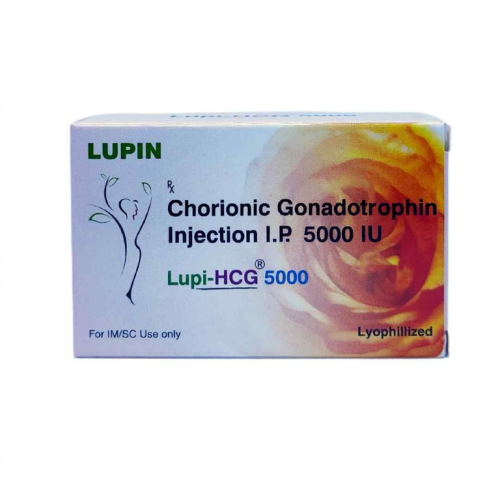- Active substance: Human Chorionic Gonadotropin
- Manufacturer: Lupin
- Unit: 1vials (5000.00IU) HCGActive substance: Human Chorionic GonadotropinOther names: HCG, Gonado, Ovidrel, Pregnyl, PubergenActive half-life: 64 hours
Human Chorionic Gonadotropin is a potent polypeptide hormone present in pregnant women. Its therapeutic applications are most common in cases such as cryptorchidism, female infertility, hypogonadism (low testosterone), and weight management.
Many users of anabolic steroids also incorporate HCG as a supplementary aid, both during steroid cycles and after cessation. When used during steroid cycles, HCG supplementation aims to address the hormonal suppression caused by steroid use. Post-cycle, it is employed to facilitate a more effective recovery.
Effects of Gonadotropin:
In contemporary discussions, one significant effect of HCG is its role as a weight loss aid. HCG diets have swiftly gained traction in western medicine, although their effectiveness is widely contested. The American Medical Association and the American Society of Bariatric Physicians have strongly criticized such diets, attributing weight loss primarily to the starvation associated with them, as caloric intake can drop to as low as 500 calories per day. HCG does not stimulate thyroid function, act as a beta-2 stimulant, suppress appetite, or possess thermogenic properties. Although some doctors report success with the HCG diet, the reliance on starvation as a strategy draws considerable criticism, raising questions about its sustainability as a healthy long-term practice. Currently, there is no definitive proof that the weight loss attributed to the HCG diet is due to the hormone itself, rather than the starvation component. This debate is likely to persist for years.
HCG's effects on anabolic steroid users can be categorized into two areas: post-cycle therapy (PCT) and on-cycle use. Anabolic steroid use suppresses natural testosterone production significantly, with the level of suppression varying based on the types and doses of steroids. When users stop steroids, testosterone production may resume on its own, yet the process can be slow, often leading to symptoms of low testosterone and loss of muscle mass as cortisol takes precedence in the absence of testosterone. To aid recovery, most steroid users will implement a PCT plan to expedite the process. While not returning levels to normal independently, a PCT plan ensures adequate testosterone for proper physiological function during recovery.
Numerous PCT protocols exist, normally involving SERMs like Nolvadex (Tamoxifen Citrate) and/or Clomid (Clomiphene Citrate). Some find that starting a PCT plan with HCG before introducing SERMs can enhance overall recovery outcomes. HCG acts similarly to luteinizing hormone (LH), preparing the body for the subsequent SERM therapy and improving recovery efficiency.
The second advantage of HCG for steroid users is its use during steroid cycles to mitigate testicular atrophy caused by suppressed testosterone secretion. Supplementing with HCG can help maintain testicular volume. While this is mainly a cosmetic benefit without tactical advantage, it may facilitate a smoother recovery post-steroid use. However, there’s a significant risk; the body can easily become reliant on HCG for its LH needs, while it does not develop a similar dependency on steroids. For individuals with pre-existing low testosterone conditions, this concern is negligible, yet HCG usage during cycles must be carefully regulated for others to prevent LH dependency. Mismanaged HCG use has led to more harm among anabolic steroid users than steroid use itself, though responsible on-cycle use can aid in a more gradual recovery.
Side effects:For anabolic steroid users on cycle, a dose of 250 IU every 4 to 5 days is common, providing enough HCG to achieve the desired effects without risking future natural testosterone production.
For PCT use, two effective dosing protocols exist. The first involves administering 1,500-4,000 IU every 3 to 4 days for 2 to 3 weeks, followed by SERM therapy. A second method, potentially more effective, is to use HCG daily at 500-1,000 IU for 10 consecutive days prior to starting SERM therapy.
Timing is crucial when incorporating HCG into PCT. If the steroid cycle concludes with long-acting esters, HCG therapy should begin 10 days post-injection, followed by SERM therapy after completing HCG use. Conversely, if short-acting esters are used, HCG therapy should commence 3 days after the last injection, proceeding with SERM therapy after HCG administration.

